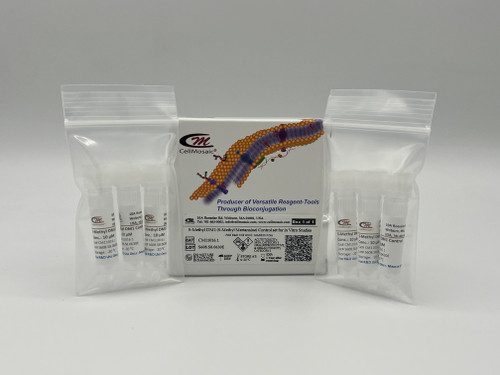Product Description
| Download Documents | |
| Product Sheet |
|
| SDS | COA_Lot#NB0320702 |
S-methyl DM1 is the primary cellular or liver metabolite of ADC or other conjugates prepared with DM1. DM1 (mertansine) is a thiol-containing derivative of maytansine. It binds to tubulin and inhibits the assembly of microtubules. DM1 is used to prepare antibody-drug conjugates, such as trastuzumab emtansine (abbreviated as T-DM1). DM1 is not very stable in aqueous solution and can be oxidized or dimerized.
CellMosaic’s S-methyl DM1 is a high purity product that can serve as a standard for HPLC and LC-MS/MS analysis. The product is formulated in DMSO solution, quantified by UV/HPLC using DM1 as standard/calibrator at 252 nm, and ready to use after dilution. Although S-methyl DM1 inhibits polymerization weaker than DM1, it can also be used as a stable control for ADC studies instead of DM1.
The product is sold as 1 vial of 1 mg (133 uL x 10 mM). If you would like to buy multiple vials, please check our Bulk Pricing:Buy in bulk and save
Chemical Information
- Chemical name: S-Methyl DM1 (S-Methyl Mertansine)
- Synonym: N2'-deacetyl-N2'-(3-methylthio-1-oxopropyl)-maytansine
- Chemical formula: C36H50ClN3O10S
- Molecular weight: 752.32 Da
- CAS number: 912569-84-7
Specifications
- Physical appearance: solution
- Storage temp.: -20 °C
- Purity: ≥ 98 % by C18 HPLC
- Concentration: 10 mM in DMSO (determined by UV/HPLC using DM1 as standard/calibrator at 252 nm)
References
- Lopus M. et al. (2010). Maytansine and Cellular Metabolites of Antibody-Maytansinoid Conjugates Strongly Suppress Microtubule Dynamics by Binding to Microtubules. Mol. Cancer. Ther. 9(1), 2689-2699.
- Oroudjev E. et al. (2010). Maytansinoid-Antibody Conjugates Induce Mitotic Arrest by Suppressing Microtubule Dynamic Instability. Cancer Ther. 9(10), 2700-2713.
- Davis J.A. et al. (2012) In Vitro Characterization of the Drug-Drug Interaction Potential of Catabolites of Antibody-Maytansinoid Conjugates. Drug Metabolism and Disposition 40(10), 1927-1934.
Frequently Asked Questions:
If you can’t find the answer you’re looking for or need information on general topics, please visit the main Frequently Asked Questions (FAQs) section.










